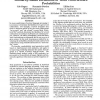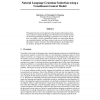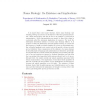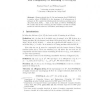770 search results - page 12 / 154 » Subsequence similarity language models |
ECAL
2001
Springer
14 years 28 days ago
2001
Springer
Abstract. In this paper we explore the similarities between a mathematical model of language evolution and several A-life simulations. We argue that the mathematical model makes so...
ACL
1994
13 years 9 months ago
1994
In many applications of natural language processing it is necessary to determine the likelihood of a given word combination. For example, a speech recognizer may need to determine...
NIPS
2001
13 years 9 months ago
2001
This paper presents a novel approach to the unsupervised learning of syntactic analyses of natural language text. Most previous work has focused on maximizing likelihood according...
CORR
1998
Springer
13 years 8 months ago
1998
Springer
It is argued that colour name strategy, object name strategy, and chunking strategy in memory are all aspects of the same general phenomena, called stereotyping, and this in turn ...
ALT
2006
Springer
14 years 5 months ago
2006
Springer
Higman showed that if A is any language then SUBSEQ(A) is regular, where SUBSEQ(A) is the language of all subsequences of strings in A. We consider the following inductive inferenc...




